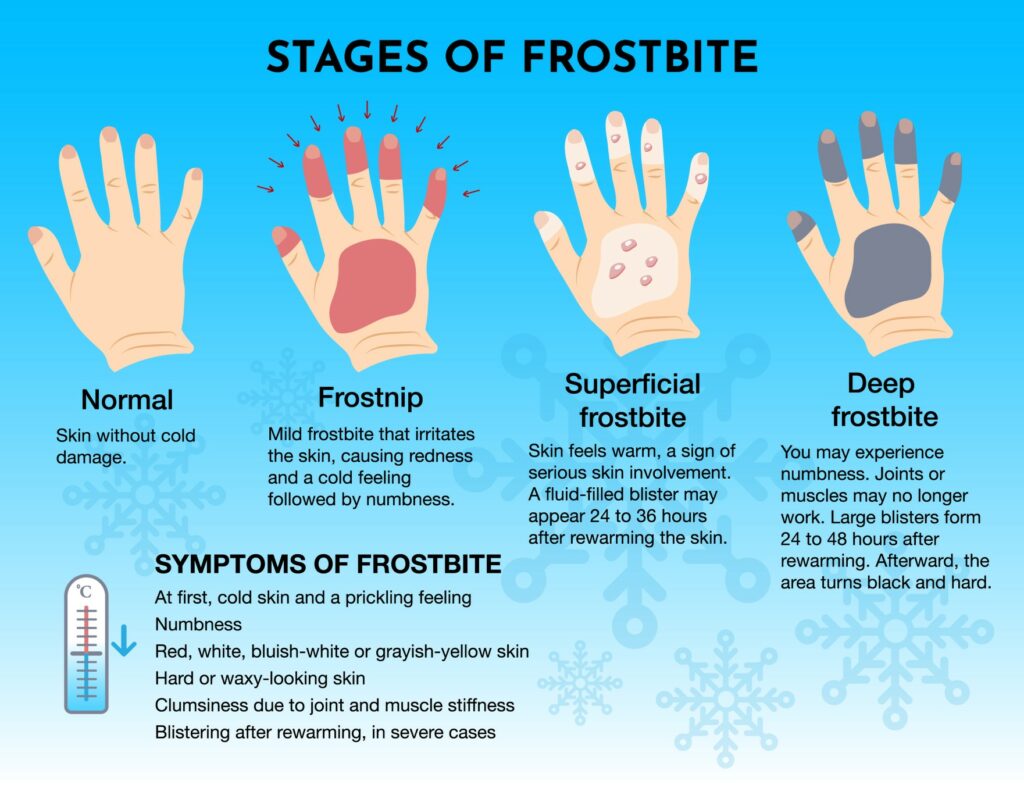
Heavy Rain, Flooding, and Chance of Severe Weather Staring Down the Southern U.S.
January 22, 2024
Posted: December 15, 2023 12:05 pm





The arrival of the bitterly cold Arctic air across much of the U.S. this week has put a spotlight on the dangers of frostbite. Here is what you need to know about this injury and how you can prevent it.
Frostbite is a serious injury that happens when the skin and the underlying tissues freeze. While the earliest stages of frostbite do not lead to permanent damage, this condition left untreated can cause serious issues. Some of the severe complications of frostbite include pain, numbness, and increased sensitivity to the cold. In the most serious cases, amputation of the affected areas may be needed to remove the dead tissue.
Frostbite is most commonly found on the outer extremities of the body such as the nose, ears, cheeks, fingers, and toes. You are at a greater risk of frostbite if you are exposed to cold temperatures for long periods of time. This risk goes up if the cold temperatures are paired with gusty winds. In addition, those at a higher altitude are at an increased risk. Lastly, frostbite can also happen if the skin is exposed to direct contact with ice or extremely cold liquids.
Frostbite typically occurs over several stages, making it important that you recognize these different phases and catch it before it advances and becomes more serious. Frostnip is the first stage of this condition, resulting in numbness to the impacted areas. This mild type of frostbite causes numbness, tingling, and slight pain. Frostnip does not lead to permanent or serious damage to the skin.

You can treat frostnip at home by rewarming the impacted area in warm water for about 15 minutes. However you should not use hot water or heating pads as these can cause burns.
The second stage of the progression is known as superficial frostbite. During this stage, you may notice a slight change to the color of the skin. Skin that starts to feel warm is a sign that the frostbite is setting in deeper. You may begin to notice that skin appears mottled if you attempt to warm it up. Other signs of superficial frostbite include stinging, swelling, or burning of the skin. Some sufferers notice the appearance of a blister filled with fluid approximately 12 to 36 hours after the skin warms.
It is important to contact a healthcare provider if you suspect that you have progressed to this stage of frostbite. A medical care professional will work to rewarm the area in addition to providing pain medication to deal with the discomfort that will happen as the skin begins to warm up again. Your doctor may also give you intravenous (IV) fluids to ensure proper hydration. Should you experience blisters, you may need to have them professionally drained and treated with antibiotics to prevent further infection.
Deep frostbite is the last stage, indicating that the condition has impacted all of the layers of the skin in addition to the tissue lying below the surface. During this serious stage, the skin begins to turn white or gray. Because you lose all feeling in the skin, you may not even notice the frostbite. The muscles and joints surrounding the impacted skin may stop working. By the time that blisters begin to form 24 hours later, it may be too late to save the skin and tissue. A blackening and hardening of the tissue happens as it dies.
This last stage of frostbite necessitates immediate medical attention. In addition to the standard course of treatment of rewarming, pain medication, and IV fluids, the doctor may need to prescribe a clot-busting medication. This treatment will boost blood flow to the impacted area and mitigate the odds of dangerous blood clots.
It is likely that your doctor will want to see you again in a few weeks to assess the permanent damage. In the most severe cases, you may need to undergo surgery or amputation.
The good news is that you can prevent frostbite entirely with some common sense precautions.
Understanding all of this information and taking the appropriate action will help you to avoid frostbite if you live in a cold climate.
Did you find this content useful? Feel free to bookmark or to post to your timeline for reference later.

January 21, 2024

January 19, 2024

January 18, 2024